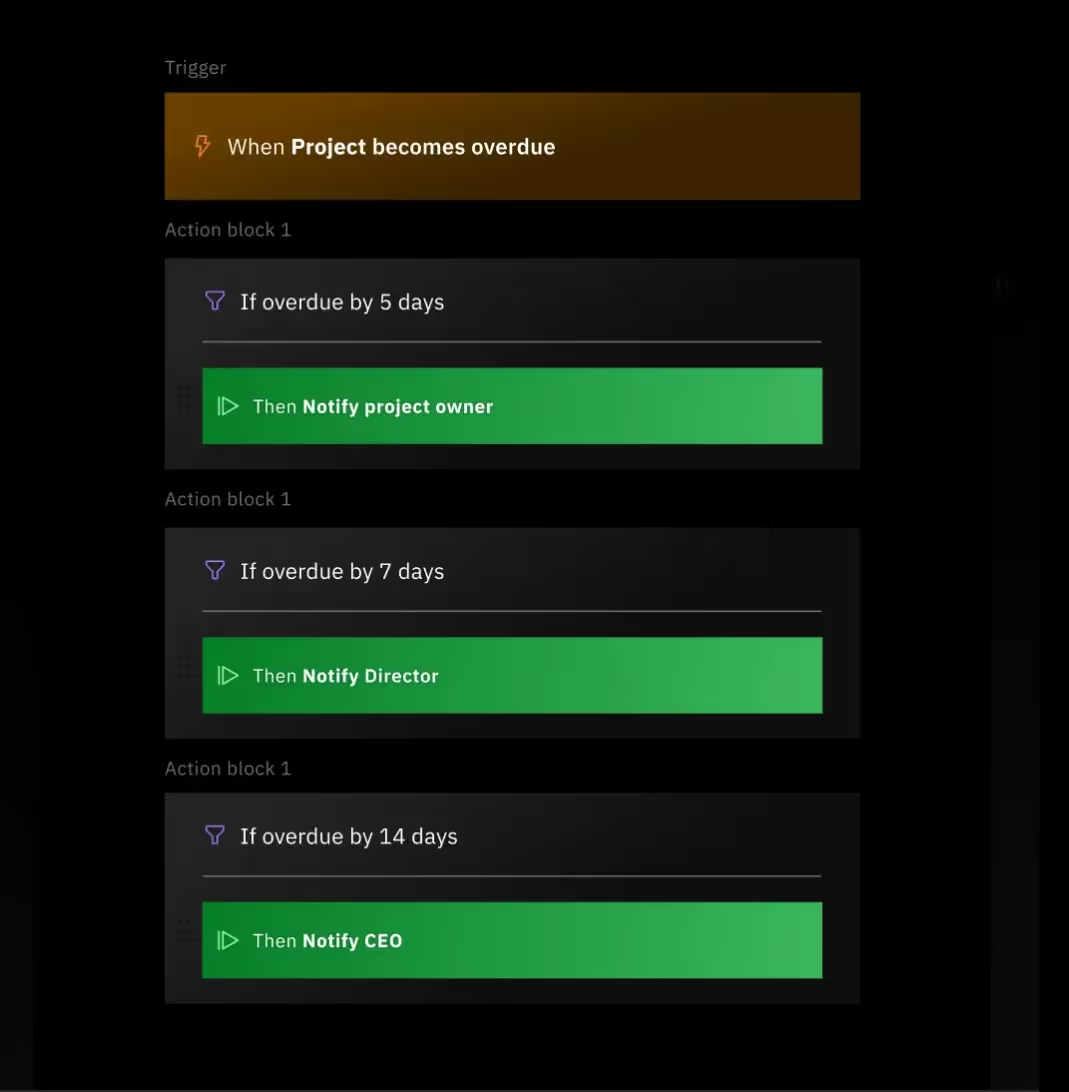During the Cold War, US officials feared communism spreading across Southeast Asia.
They believed that if South Vietnam fell, then so would neighboring countries. This fear was called the "domino theory", with Eisenhower explaining it as the beginning of a disintegration that would have far-reaching influences.
In the realm of project management, the significance of the initial signs of disintegration is often overlooked until they start to have a profound impact. And while it may not lead to warring nations, the “domino effect” of delays occurs when a minor delay in a project's timeline triggers a series of subsequent delays, ultimately affecting the project's overall completion.
A seemingly minor one-day delay, if left unaddressed, can create a situation where the project team becomes comfortable with accepting one-day delays in various aspects of the project. Over time, this could snowball into a significant setback of 10 to 20 days for the entire project.
But how do you ensure your projects are running smoothly? How do you make sure you preempt hiccups and have a plan for when unspeakable things hit the fan?
Enter project governance.
It’s a practice that acts as a guardrail to ensure better adherence to project timelines and seamless project execution.
Good project governance will be woven in through every stage of the project lifecycle; it will not be reserved for specific phases or when things go out of control.
This blog will dive into eight must-have systems and practices for mature project governance at your organization.
1. Process adherence tracking and quality checkpoints
Process adherence tracking and quality checkpoints are crucial in ensuring project success. These steps help maintain consistency, identify areas of improvement, and ensure that project deliverables meet the desired quality standards.
Here are six key factors to consider while tracking process adherence and quality:
1. Clearly defined execution methodology: Start by establishing a well-defined methodology with the phases, key deliverables, outcomes, and workflow. Codify, document, and verify the execution playbook through a systems-first approach–this becomes a forcing function to capture and ensure adherence.
It is also important to define the steps, roles, and responsibilities of everyone involved. Having these processes laid out prevents ambiguity and ensures that everyone involved is on the same page.
2. Regular monitoring: Once the processes are in place, monitoring adherence to them is essential. This can be done through regular check-ins, progress reporting, and milestone tracking. You can identify deviations early on by monitoring adherence and taking corrective actions.
Or, you could use Rocketlane’s automations to set up alerts and use the Interval IQ report to track milestones, time-to-value, and more.
3. Tracking performance metrics: Identify and track metrics that provide insights into the efficacy of your project processes, teams, and systems.
These metrics can include KPIs such as project timelines, resource utilization, and quality of deliverables. By regularly measuring these metrics, you can identify areas of your process and project execution that require improvement and make necessary adjustments.
4. Quality checkpoints: Quality checkpoints are essential milestones throughout the project that allow for quality assurance and verification. These checkpoints ensure that project deliverables meet the desired quality standards. They can include design reviews, code reviews, and user acceptance testing.
5. Documentation and reporting: Proper documentation and reporting of adherence to processes and quality checkpoints are crucial for project governance. This includes detailed records of observed deviations, corrective actions, and lessons learned. These records provide valuable insights for future projects and help to maintain accountability.
6. Continuous improvement: One of the main objectives of project governance should be continuous improvement. Use the data collected from process adherence tracking and quality checkpoints to identify areas where processes can be enhanced. Implementing feedback loops and incorporating lessons learned into future projects will help optimize project governance and increase the chances of project success.
2. Project health dashboards
A project health dashboard visualizes key project performance indicators (KPIs) for projects based on various factors such as scope, timeline, quality, and customer sentiment. It helps identify red and amber projects and also provides relevant data in a user-friendly and easily digestible format.
These KPIs may include milestone accomplishment, budget adherence, resource utilization, and risk assessment. Having these metrics in one centralized place helps easily identify potential issues, bottlenecks, or deviations from the project plan at a glance. This means you can proactively address issues before they become major roadblocks.
For instance, if you notice a budget deviation or resource constraint on the dashboard, you can create timely action plans to help your project stay the course - changing the resource plan, re-visiting the scope or budget with the client, etc.
Furthermore, project health dashboards facilitate effective communication and collaboration among project team members and stakeholders. They encourage transparency and facilitate discussions around potential risks and mitigation strategies by providing a shared understanding of the project's status. This allows for early identification of issues and a collaborative approach to problem-solving, ultimately enhancing project outcomes.
3. Early warning systems
Early warnings are essential to project management as they help project managers avoid potential delays, cost overruns, or other negative consequences. This ongoing process involves constant monitoring and analysis of project performance indicators such as schedule, budget, quality, and scope.
Establishing an early or proactive warning system helps alert the internal hierarchy before it is too late. It mainly prevents project delays and enables de-risking.
Early warning systems may consist of automated alerts that your system will trigger by specific conditions (such as KPIs crossing specific thresholds), regular status reports highlighting deviations from the plan, and risk registers tracking identified risks and their mitigation plans.
Set up a structured system that automatically triggers and tracks each step of a specific event or milestone that serves as a significant catalyst for initiating the next project phase, or to send timely alerts on project escalations.
It begins with defining specific escalation criteria related to project objectives, such as cost overruns, delays, or quality issues. Different escalation levels are established based on severity, with predefined actions and responsible parties for each level. Automation tools are integrated to monitor project metrics in real time, automatically triggering alerts when criteria are met. These alerts are time-sensitive and are directed to the appropriate person or team, providing clear information about the issue and initial recommendations.

Response actions, such as meetings, requests for mitigation plans, or resource allocation, are defined for each level. Regular monitoring and review of this structure help fine-tune the process for ongoing project governance, ensuring that issues are addressed proactively and increasing the likelihood of project success.
The benefits of early warning systems are multifold. They enable proactive risk management, reducing the likelihood of surprises and disruptions. Moreover, they bolster communication within the team and with external stakeholders, fostering a collaborative and responsive project environment.
4. Risk management and mitigation
The world of project governance often contends with complex challenges, risks, and uncertainties. This is where risk management and mitigation come into place. It involves identifying potential threats, assessing their impact, and implementing mitigation strategies before they escalate into major problems.
By recognizing risks early and taking strategic action to address them, project managers can fortify timelines, budgets, and overall project health. Effective risk management in project governance establishes accountability for identifying, assessing, and mitigating risks. This accountability encourages responsible behavior in team members and ensures that risks are not overlooked or downplayed.
Effective risk management and mitigation help protect the interests of various stakeholders, including investors, customers, employees, and regulatory bodies. It minimizes the chances of project failure, which could lead to financial losses or damage to the organization's reputation. Risk management provides decision-makers with critical information about potential threats and opportunities related to the project. This information helps make informed decisions, such as whether to proceed with the project, adjust its scope, or allocate additional resources.
5. Change request management
In any project, changes are inevitable. Managing these changes effectively, whether a small modification or a major alteration, is crucial for the project's success. This is where change request management comes into play.
Change request management is a systematic process that enables project teams to evaluate, prioritize, and implement proposed changes. It ensures that changes are made in a controlled manner, minimizing risks and maximizing project outcomes. A change request management plan should include change request templates or forms to ensure consistency in the process.
One of the primary benefits of change request management is that it provides a structured approach to handling changes. Instead of making ad-hoc modifications, project teams can follow a predefined process. This allows them to assess the impact of the change on project scope, schedule, budget, and resources. Proper change request management also helps maintain project controls. It ensures that changes are reviewed by relevant stakeholders and approved by the appropriate authorities. This promotes transparency and accountability within the project governance structure.
Effective change request management leads to improved project planning. Project teams can identify potential risks and devise mitigation strategies by evaluating proposed changes. This enables them to assess the feasibility of the change and make informed decisions.
Furthermore, change request management facilitates communication and collaboration among project stakeholders. Through a centralized system, team members can track the progress of change requests and provide relevant feedback. This promotes a culture of transparency and helps align project objectives with stakeholders' expectations.
6. Critical path management and key milestone accountability
Critical Path Management (CPM) and Key Milestone Accountability are two essential components of project governance that help organizations effectively plan, track, and complete projects. Critical Path Management focuses on identifying the most critical activities or tasks that must be completed on time for a project to stay on schedule.
This involves creating a logical sequence of activities and determining their dependencies. By identifying the critical path, project managers can prioritize and allocate resources accordingly, ensuring that the most important tasks are given attention. This helps minimize delays and bottlenecks and keeps projects on track.
Key Milestone Accountability, on the other hand, involves setting clear milestones or significant progress points that must be achieved throughout the project's lifecycle. These milestones serve as checkpoints, allowing project managers to assess progress and make necessary adjustments if needed. By holding individuals or teams accountable for meeting these milestones, project managers can ensure that projects progress and potential issues are promptly addressed.
Critical path management and key milestone accountability are crucial aspects of project governance as they enable organizations to plan, track, and complete projects effectively within the allocated timeframes and budgets.
Project managers can enhance project success rates, improve communication and collaboration among team members, and ultimately deliver high-quality results to stakeholders by ensuring these aspects of project governance are present.
7. Steering committees
An essential component of effective project governance is establishing a steering committee.
A steering committee is an advisory board that has governance over a company, campaign, or anything in between. Steering committees are composed of experts, authority figures, and senior stakeholders. They play a crucial role in ensuring that projects are aligned with organizational priorities, goals, and objectives.
The five key aspects of establishing a successful steering committee:
1. Clear purpose: The steering committee should have a well-defined purpose and scope. It should serve as a governing body that oversees the project's strategic direction, decision-making, and resource allocation. Defining the purpose upfront will help clarify and focus the committee's activities.
2. The right people: Steering committee meetings are unlike every other calendar meeting. Done right, they can help you stick to project timelines and work with your clients effectively. So how do you get it right? By making sure the right people are in it: the key executive sponsor from the customer’s team, and leaders or executives with the right context. They can help unblock you and ensure delays at their end are corrected through swift communication and decision-making.
3. Defined roles and responsibilities: Clearly define the roles and responsibilities of the steering committee members. This includes outlining their decision-making authority, accountability, and communication requirements. Assigning specific tasks and roles will facilitate efficient collaboration and avoid confusion.
4. Regular meetings: Regular meetings are vital for steering committee effectiveness. Establish a consistent meeting schedule and ensure that meetings are well-structured and focused. Encourage active participation and allow members to share updates, raise concerns, and make informed decisions.
5. Regular communication and reporting: Establish a communication plan that outlines how information will be shared with the broader project team and stakeholders. Regularly report project progress, risks, and issues to keep everyone informed and aligned. Open and transparent communication will foster trust and promote effective decision-making.
8. Customer sentiment monitoring
Customer sentiment monitoring involves collecting and analyzing customer feedback and opinions to gain insights into their experiences, satisfaction levels, and overall sentiment toward your project. This can be done through various channels, such as CSAT surveys or direct feedback from customer support interactions.
Here are five key project governance benefits of tracking customer sentiment:
1. You can identify areas for improvement: By monitoring customer sentiment, you can identify pain points and areas where your project may fall short. This information can help you prioritize improvement efforts and adjust to deliver a better customer experience.
2. It enables proactive problem-solving: You can detect emerging trends and issues early on by tracking sentiment. This allows you to address them proactively, preventing potential escalation and reducing the overall impact on your project's success.
3. Enhanced customer satisfaction: Positive customer sentiment indicates that your project meets or exceeds expectations. By monitoring sentiment, you can ensure that you continue delivering what your customers value, leading to increased satisfaction, loyalty, and positive word-of-mouth.
4. Better decision-making: Customer sentiment provides valuable insights that can enable decision-making at various levels, from product development and marketing strategies to customer support efforts. It helps you align your project with customer needs and preferences, increasing the chances of success.
5. Get ahead of the curve: Customer satisfaction checkpoints at various levels of the project will help proactively assess the customer’s satisfaction at all times and help us understand where we went wrong in case of any roadblocks and prevent project delays.
Now that you know the best practices and tricks to up your project governance, what’s next?
Get the right tool, of course!
Get Rocketlane for unmatched project governance
Solid project governance is the strong pillar upon which successful projects are built. Establishing and maintaining a solid project governance provides the necessary framework for organizations to ensure that their projects stay on track and deliver results as intended. These best practices aren’t just good to have but rather a must-have for organizations. Project governance is quintessential in achieving project excellence.
Rocketlane can help! Book a demo today and get your project delivery into the fast lane!















